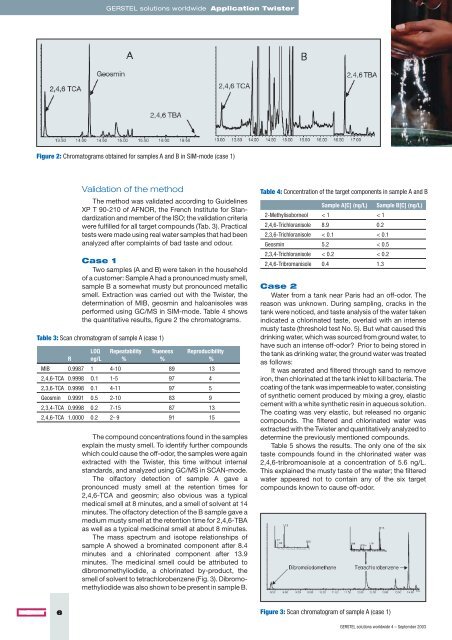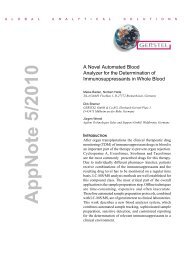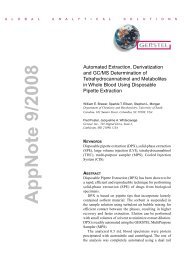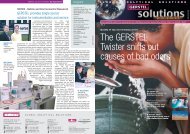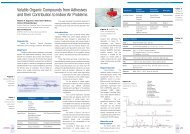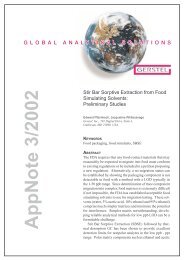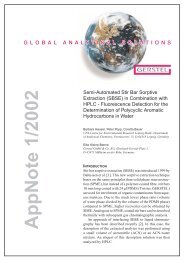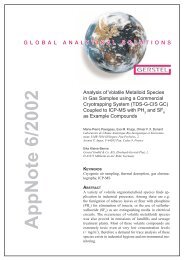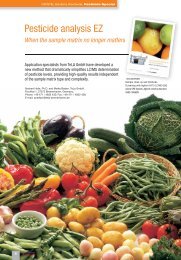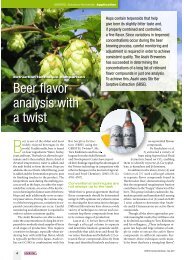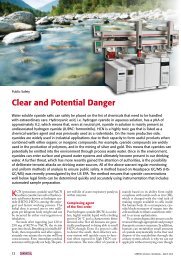GERSTEL Twister sniffs out causes of bad odors
GERSTEL Twister sniffs out causes of bad odors
GERSTEL Twister sniffs out causes of bad odors
Create successful ePaper yourself
Turn your PDF publications into a flip-book with our unique Google optimized e-Paper software.
<strong>GERSTEL</strong> solutions worldwide Application <strong>Twister</strong><br />
Figure 2: Chromatograms obtained for samples A and B in SIM-mode (case 1)<br />
Validation <strong>of</strong> the method<br />
The method was validated according to Guidelines<br />
XP T 90-210 <strong>of</strong> AFNOR, the French Institute for Standardization<br />
and member <strong>of</strong> the ISO; the validation criteria<br />
were fulfilled for all target compounds (Tab. 3). Practical<br />
tests were made using real water samples that had been<br />
analyzed after complaints <strong>of</strong> <strong>bad</strong> taste and odour.<br />
Case 1<br />
Two samples (A and B) were taken in the household<br />
<strong>of</strong> a customer: Sample A had a pronounced musty smell,<br />
sample B a somewhat musty but pronounced metallic<br />
smell. Extraction was carried <strong>out</strong> with the <strong>Twister</strong>, the<br />
determination <strong>of</strong> MIB, geosmin and haloanisoles was<br />
performed using GC/MS in SIM-mode. Table 4 shows<br />
the quantitative results, figure 2 the chromatograms.<br />
Table 3: Scan chromatogram <strong>of</strong> sample A (case 1)<br />
LOQ Repeatability Trueness Reproducibility<br />
R ng/L % % %<br />
MIB 0.9987 1 4-10 89 13<br />
2,4,6-TCA 0.9998 O.1 1-5 97 4<br />
2,3,6-TCA 0.9998 0.1 4-11 97 5<br />
Geosmin 0.9991 0.5 2-10 83 9<br />
2,3,4-TCA 0.9998 0.2 7-15 87 13<br />
2,4,6-TCA 1.0000 0.2 2- 9 91 15<br />
The compound concentrations found in the samples<br />
explain the musty smell. To identify further compounds<br />
which could cause the <strong>of</strong>f-odor, the samples were again<br />
extracted with the <strong>Twister</strong>, this time with<strong>out</strong> internal<br />
standards, and analyzed using GC/MS in SCAN-mode.<br />
The olfactory detection <strong>of</strong> sample A gave a<br />
pronounced musty smell at the retention times for<br />
2,4,6-TCA and geosmin; also obvious was a typical<br />
medical smell at 8 minutes, and a smell <strong>of</strong> solvent at 14<br />
minutes. The olfactory detection <strong>of</strong> the B sample gave a<br />
medium musty smell at the retention time for 2,4,6-TBA<br />
as well as a typical medicinal smell at ab<strong>out</strong> 8 minutes.<br />
The mass spectrum and isotope relationships <strong>of</strong><br />
sample A showed a brominated component after 8.4<br />
minutes and a chlorinated component after 13.9<br />
minutes. The medicinal smell could be attributed to<br />
dibromomethyliodide, a chlorinated by-product, the<br />
smell <strong>of</strong> solvent to tetrachlorobenzene (Fig. 3). Dibromomethyliodide<br />
was also shown to be present in sample B.<br />
Table 4: Concentration <strong>of</strong> the target components in sample A and B<br />
Sample A[C] (ng/L)<br />
2-Methylisoborneol < 1 < 1<br />
2,4,6-Trichloranisole 8.9 0.2<br />
2,3,6-Trichloranisole < 0.1 < 0.1<br />
Geosmin 5.2 < 0.5<br />
2,3,4-Trichloranisole < 0.2 < 0.2<br />
2,4,6-Tribromanisole 0.4 1.3<br />
Sample B[C] (ng/L)<br />
Case 2<br />
Water from a tank near Paris had an <strong>of</strong>f-odor. The<br />
reason was unknown. During sampling, cracks in the<br />
tank were noticed, and taste analysis <strong>of</strong> the water taken<br />
indicated a chlorinated taste, overlaid with an intense<br />
musty taste (threshold test No. 5). But what caused this<br />
drinking water, which was sourced from ground water, to<br />
have such an intense <strong>of</strong>f-odor? Prior to being stored in<br />
the tank as drinking water, the ground water was treated<br />
as follows:<br />
It was aerated and filtered through sand to remove<br />
iron, then chlorinated at the tank inlet to kill bacteria. The<br />
coating <strong>of</strong> the tank was impermeable to water, consisting<br />
<strong>of</strong> synthetic cement produced by mixing a grey, elastic<br />
cement with a white synthetic resin in aqueous solution.<br />
The coating was very elastic, but released no organic<br />
compounds. The filtered and chlorinated water was<br />
extracted with the <strong>Twister</strong> and quantitatively analyzed to<br />
determine the previously mentioned compounds.<br />
Table 5 shows the results. The only one <strong>of</strong> the six<br />
taste compounds found in the chlorinated water was<br />
2,4,6-tribromoanisole at a concentration <strong>of</strong> 5.6 ng/L.<br />
This explained the musty taste <strong>of</strong> the water; the filtered<br />
water appeared not to contain any <strong>of</strong> the six target<br />
compounds known to cause <strong>of</strong>f-odor.<br />
6<br />
Figure 3: Scan chromatogram <strong>of</strong> sample A (case 1)<br />
<strong>GERSTEL</strong> solutions worldwide 4 – September 2003


